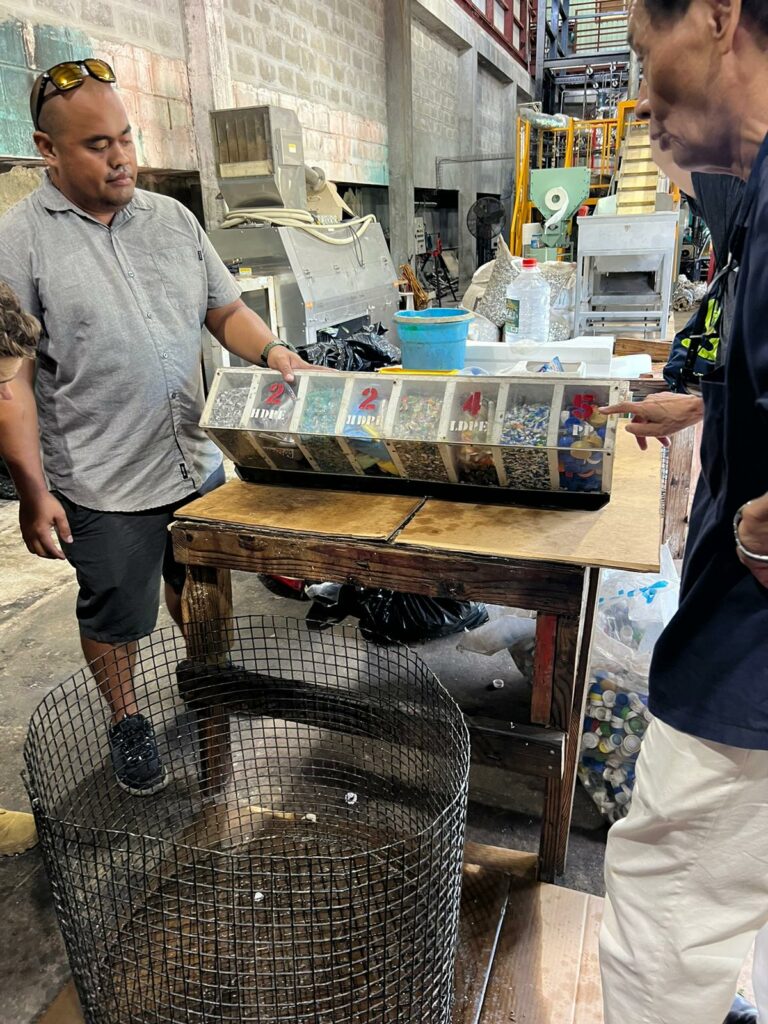We all loaded up in the Mesekiu bus yet again and ventured back up north through the winding mountain roads to the PCC Multispecies Hatchery. We met Richard Page, an aquaculturist who has worked at the facility over a year. The facility is a polyculture center that houses and reproduces multiple types of sea creatures such as sea cucumbers, tiger shrimp, rabbit fish, giant clams, mangrove crab, and some rescued hawksbill turtles. Just in the last year this institution has grown exponentially, increasing their success in aquaculture production. In the past eight months they released 16.5 million mangrove crab megalope into the ocean.

(Group gathering around the sea cucumber tanks)
The tour began in the lab where they culture the algae in mother cultures and transfer them into water jugs. There are three different types (CM, Nano, ISO) that are used as the base for the aquaculture feed.

(The three types of algae)
There were three different tanks with tiger shrimp. Tank 1 had a high protein feed, tank 2 had a Taiwanese feed, and tank 3 had a low protein feed. We observed that the shrimp in tank 1 were the largest around 200 grams and had much more color and energy.

(Tiger Shrimp chilling out)
We moved our tour to the sea cucumber tanks where there were two different types. Most interesting was the Stichopus cucumber contains the highest amount of fucan sulfites. These sea cucumbers can be segmented into additional ones. Richard Page has been studying the effects of the holothurin toxin that they contain and the regenerative processes that they can have. When mixed with stem cells they have the potential to help with growing skin, cartilage, and ligaments.

(Veronica, Rebecca, and Abby holding sea cucumbers)
We returned to PCC for a quick break and then returned to our bus to make our way to the Koror Solid Waste Facility. It is a multi operational facility ran by the local government. Here they separates the glass from the plastic and compost.

(The group photo in front of Koror Solid Waste Facility)
Onsite it contains the Belau Eco Glass Studio that turns the glass in the recycling process into art.

(Belau Eco Glass Center sign)

(Recycled glass art replication of Palauan women’s money (Bachel))
Part of the waste facility is dedicated to recycling plastic into a synthetic Diesel fuel. The process begins with separating plastic into four categories, cutting them up into tiny bits, washing, drying, and then heating that into a gas that distills into the end product of fuel. This process creates enough energy to fuel itself with a 10% surplus. The Chief engineer of the facility told us that they would like to expand the operation to process all of Palau’s waste plastic, but they are facing a prohibitive cost and a lack of personnel. We also learned how the Japanese government gave Koror a grant (in alignment with the UN mission for sustainability) to replace equipment lost in a 2017 fire.

(Separated plastic shreds)
We came back to PCC and toured their 3D printing lab where they had made lots of these cool fruit fly traps that twist onto plastic bottles. They also had a giant lantern trap for Rhinoceros Beetles. One type of the beetle lives in a coconut tree and spreads a disease into the trees which can eventually kill them. The lantern traps have a light and pheromone pouch that lures them inside.

(Bryan, Scott and KB introducing the Rhinoceros traps)
This day gave a lot of insight into how the Palauan community, government, and outside partnerships collaborate to solve sustainability issues and to better improve the cultural and economic environment.
This blog was written by: Alanna and Brittney (With some help from Alex and KB)


























































































